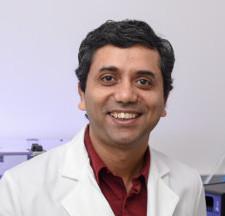
Credit: UT Southwestern Medical Center
DALLAS – March 28, 2018 – A delicate balance during brain development could have profound implications for understanding and treating medulloblastoma, the most common malignant brain tumor affecting children.
Medulloblastoma of the Sonic Hedgehog subtype can occur at any age, but it is most often seen in children. When not fatal, the disease is marked by severe neurocognitive disabilities. How Sonic Hedgehog subtype tumors develop has been poorly understood, said Dr. Saikat Mukhopadhyay, Assistant Professor of Cell Biology at UT Southwestern and senior author of a recent study featured on the cover of Cell Reports. By detailing the mechanisms underlying development of these tumors, these findings could lead to new treatments, noted Dr. Mukhopadhyay, a W.W. Caruth, Jr. Scholar in Biomedical Research.
Medulloblastomas originate in the cerebellum, an area at the skull's base that regulates motor control, posture, and balance. The Sonic Hedgehog subtype of medulloblastoma occurs when too many of a particular brain cell type — granule cells — are made. Granule cells make up most of the cerebellum and constitute as much as 80 percent of all brain neurons. During normal development, many granule cells are made when other nearby cells release the protein Sonic Hedgehog. However, some granule cells are made in the cerebellum even before Sonic Hedgehog is released, which led the researchers to investigate other factors that regulate early granule cell production.
"We modeled the Sonic Hedgehog medulloblastoma in mice by deleting a gene for a G protein-coupled receptor called Gpr161 that was not known to be involved in this tumor," said first author Dr. Issei Shimada, Assistant Instructor in Cell Biology. "Interestingly, we found that in the absence of Gpr161, which actively represses the downstream pathway, the granule cells proliferate even before Sonic Hedgehog is secreted."
Dr. Mukhopadhyay added, "Repression of the downstream pathway in the absence of Sonic Hedgehog is as important as activation in its presence. Bottom line: The granule cell behaves like a car on a downhill slope with the hand brake on. Loss of the hand brake is as damaging as the accelerator being pressed too hard."
This means that Gpr161 acts as a tumor suppressor for Sonic Hedgehog medulloblastomas by preventing too many granule cells from being made.
Medulloblastomas account for 15 to 20 percent of all pediatric brain tumors, according to the National Institutes of Health. While they are most commonly diagnosed in children between ages 3 and 8, they can be seen in all age groups. About 350 cases are diagnosed each year in the U.S.
In 2017, a survey of the National Cancer Database tracked 4,032 patients with medulloblastomas. Of these, 1,300 were age 18 or younger and received chemotherapy and radiation treatment. The median age was 8.4 years, and the group's five-year survival rate was 79 percent.
Only one drug, vismodegib, currently targets the upstream Sonic Hedgehog pathway for treating these pediatric tumors, Dr. Mukhopadhyay said. Now that this work has identified Gpr161 as a tumor suppressor, focusing on Gpr161 might be a new strategy to inhibit progression of tumors that develop resistance to drugs targeting the upstream Sonic Hedgehog pathway, he said.
###
UT Southwestern team members from Cell Biology, Bioinformatics, Internal Medicine, and Pathology contributed to the study, as did researchers from Children's Health, UT Dallas, and the Hospital for Sick Children in Toronto
About UT Southwestern Medical Center
UT Southwestern, one of the premier academic medical centers in the nation, integrates pioneering biomedical research with exceptional clinical care and education. The institution's faculty has received six Nobel Prizes, and includes 22 members of the National Academy of Sciences, 17 members of the National Academy of Medicine, and 14 Howard Hughes Medical Institute Investigators. The faculty of more than 2,700 is responsible for groundbreaking medical advances and is committed to translating science-driven research quickly to new clinical treatments. UT Southwestern physicians provide care in about 80 specialties to more than 100,000 hospitalized patients, 600,000 emergency room cases, and oversee approximately 2.2 million outpatient visits a year.
Media Contact
Patrick Wascovich
[email protected]
@UTSWNews
http://www.swmed.edu
Original Source
http://www.utsouthwestern.edu/newsroom/articles/year-2018/pediatric-brain-tumor.html





